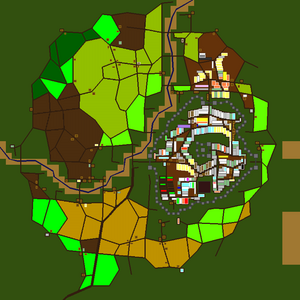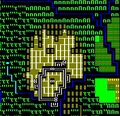- v50 information can now be added to pages in the main namespace. v0.47 information can still be found in the DF2014 namespace. See here for more details on the new versioning policy.
- Use this page to report any issues related to the migration.
Town
v52.04 · v0.47.05 This article is about the current version of DF.Note that some content may still need to be updated. |
- "Town" may also refer to a fortress that has reached a certain population level.
A town is a large site founded and inhabited by humans.
Adventurers spend much quality time in towns. They can come to trade, speak, or entertain the townspeople and occasionally to slay those who have invited their wrath. Taverns in towns are a popular destination for many adventurers; they are the only sources of alcohol in a human civilization and make for excellent entertainment with their residing performers. Other people of interest include mercenaries, who will gather at taverns and make for great traveling companions.
Keep
At the heart of a town is a walled stronghold held by many soldiers. Inside of the keep can be found a lord/lady, other high nobility, men-at-arms willing to follow you unto death, and well guarded treasure. If the town is the civ's seat of power, then the law-maker will also reside here. Under the keep is a dungeon, a dangerous but rewarding place to wander.
Town proper
Outside of the keep is the realm of the bourgeoisie. Commuters and travelers walk along the densely packed houses and shops in narrow streets. Stray domesticated animals roam the muddy alleyways or the pastures near town limits. Vast markets and shopping districts are major trade centers. Other buildings include warehouses that are stockpiled with goods (which can be ransacked without repercussion) and wells where townspeople can gather and socialize. Common structures include taverns and temples. Libraries are very rare.
Below is a list of different shops and markets found in a town. Most towns do not have every single retail available, and adventurers may have to travel to a different town in order to browse the wares of a distinctive type. The shops that are "common" are common because only animal products (meat, bone, leather) and farm products (cloth and food) are produced in any significant numbers. Stone, wood, and metal are all extremely rare materials in towns and because of this, few industries based upon these materials will spring up. An exception is the leather goods shop, which is fairly uncommon compared to other leather shops.
Common shops:
- µ General imports
- % Food imports
- [ Clothing imports
- [ Woven clothing shop
- º Cloth shop
- [ Leather clothing shop
- ß Leather shop
- Å Bone carver's shop
Rare shops:
- ╤ Carpenter's shop
- ╤ Stone furniture shop
- ╤ Metal furniture shop
- ♦ Gem cutter's shop
- [ Armorsmith's shop
- / Bowyer's shop
- / Weaponsmith's shop
- Å Leather goods shop
- Å Metal craft shop
In a Market one can find:
- Imported goods
- Imported food
- Imported clothing
- Meat
- Fruit and vegetable
- Cheese
- Processed goods
Subterranea
Below a town are several subterranean structures: dungeons, catacombs, and sewers. All three can be present at once and frequently connect or overlap each other. Criminals, outcasts of society and various subterranean creatures hide within the dark rooms and passages. They are common destinations for those looking to finish a quest, gain reputation, or search for valuable loot that are scattered everywhere.
Dungeons reside below the keep, while catacombs reside below temples. Both buildings are almost always present. Sewers on the other hand can be only found in more developed towns. Knowing whether a sewer is present in a town is identifiable by floor grates in the middle of streets. They are accessible via small and elusive entrances above-ground or by diving below nearby waterways.
Criminal organizations
Most towns have criminal organizations, formed by a collection of outcasts. They are led by a boss. Criminal organizations can take over one of the subterranean structures, but they don't tend to harm anyone or do anything hostile. Despite their current lack of threat, they are still the targets of certain quests.
Destroyed or abandoned towns
- Further information: Ruin
In time, whether by war, beasts, a genocidal adventurer, or some other disaster, towns will be brought to ruin. Ruined towns are typically desolate wastelands of abandoned and destroyed buildings and structures. Shops and markets are typically bare, but occasionally some goods can still be left for you to steal. Bandits and criminals may still lurk the streets, and may even make the ruins their home, if some supernatural creature or monster haven't made themselves cozy already.
Gallery
"Town" in other Languages
|
Worlds | |||||||||
|---|---|---|---|---|---|---|---|---|---|
| General | |||||||||
| Map |
| ||||||||
| Civilization |
| ||||||||




